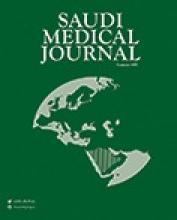To the Editor
I have 2 comments on the distinguished study by Alzanbagi et al on the growth characteristics in Saudi children with congenital adrenal hyperplasia (CAH).1
First, over the period of 5 years (January 2012 and January 2017), the authors measured the growth parameters of weight and height in CAH patients aged between 0 and 18 years. Alzanbagi et al interpreted body mass indices (BMI) of the studied patients using the World Health Organization (WHO) BMI percentile charts for age and gender. They found a significant effect of CAH on height, weight, and BMI.1 They addressed that underweight and obesity were reported in 19.1% and 17.6% of the studied population, while short stature and normal height were recorded in 25.7% and 74.3%.1 Apart from many limitations addressed by the authors, that might cast some suspicions on the accuracy of the study results, I presume that the following limitation might be additionally contributory. It is explicit that in the pediatric clinical setting, there are many growth charts employed to estimate different anthropometric indices, namely Center for Disease Control (CDC) charts, WHO charts, and country-specific charts. Evaluation of these charts suggested that country-specific charts might describe the growth of children more precisely.2 In certain populations, the clinical implementation of national charts disclosed unique patterns of BMI percentiles compared to CDC and WHO charts. These national charts were considered useful as a reference for monitoring the growth changes over time and for comparing various regions.3 To my knowledge, L, M, and S parameters as well as Z scores were calculated for weight, height, and BMI for Saudi preschool-age children,4 school-age children, and adolescents.5 They have been launched in 2016 for more accurate assessment of growth and nutrition in the clinical field and researches. I wonder why Alzanbagi et al 1 referred to WHO charts instead of the national Saudi growth charts to estimate BMI percentiles of the studied cohort. I presume that if they employed national BMI charts, different results might be obtained.
Second, in view of the high rate culturally-based consanguineous marriage (29.7%) in the Saudi general population6 and high nationwide incidence of CAH (1:7908),7 which is so far one of the greatest reported incidence worldwide, marked inbreeding cases of CAH are expected to be faced in the foreseeable time. Meticulous monitoring of the growth of these CAH patients represents a major step to be followed. Hence, establishment of Saudi-specific growth curves for CAH patients similar to that constructed in certain populations,8 is suggested.
Reply from the Author
No reply was received from the Author.
- Copyright: © Saudi Medical Journal
This is an open-access article distributed under the terms of the Creative Commons Attribution-Noncommercial-Share Alike 3.0 Unported, which permits unrestricted use, distribution, and reproduction in any medium, provided the original work is properly cited.






